The previous chapters discussed issues about animals and their products, or a particular technology that improves the output such as better feeding methods and better health services. This chapter focuses on the relationships among the components of animals, plants and soil. As with other chapters, only a selection of issues can be discussed.
Most livestock products in mixed farming systems are derived from animals that are fed on local resources such as pasture, crop residues, fodder trees and shrubs. Another feed resource consists of by-products from village industries such as oil extraction, grain milling and cane crushing. The exchange of these resources saves money and reduces waste by recycling products within the farming system. They create employment and they can contribute to soil texture and fertility while being an economic incentive for rearing multipurpose animals. As in the discussion of the other topics, relevance of technologies depends on the mode of farming. For example, in EXPAGR the animals, crops and soils are not strongly linked. Animals tend to graze elsewhere (outfields), they are a savings account and they may bring home some dung and young stock to pull the plough. However, in NCA the crops and livestock are integrated, as in LEIA, and they both serve the same goals - to keep the farming sustainable and productive. Still, under poverty conditions in LEIA, there is a tendency for good-quality feed residues to be sold off the farm, thus leaving the animals with mainly fibrous feeds. Therefore animals in LEIA tend to be a way to convert fibrous feeds, crop residues, poor-quality grazing land and weeds into draught, dung and urine, often at the expense of the land (Photo 78). In HEIA there is hardly any attention to interactions among soil, plants and animals because limiting nutrients can be bought from outside and waste is ignored until it becomes a serious problem. HEIA exists not only in temperate and rich countries, but also in tropical and poor countries (Photo 79).
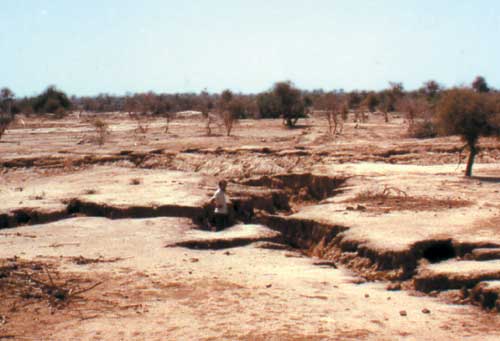
PHOTO 78
Gully erosion caused primarily by overgrazing (Senegal)
Livestock can enhance farm output by intensifying nutrient and energy cycles, particularly in LEIA and NCA. In LEIA this mainly implies a closer recycling of nutrients in straws (crop residues and fodder), dung and urine. In NCA there is scope to include leys, anti- erosion bunds and, for example, adjusted cropping patterns. NCA also has the added advantage that it can both import some nutrients in fertilizer and feed while it aims to keep the better-quality crop residues such as brans and cakes on the farm. Crop residues can be used for animal feed as well as for soil fertility and can also be sold. The farmers have to choose how to use these materials and, whatever they are used for, the choice needs to be accompanied with keen management to make the best of these resources. The fibrous crop residues have a potential in soil conservation through mulching but even the oilseed cakes can be used to improve soils. Some terms related to animal-plant-soil interaction are explained in Table 9.
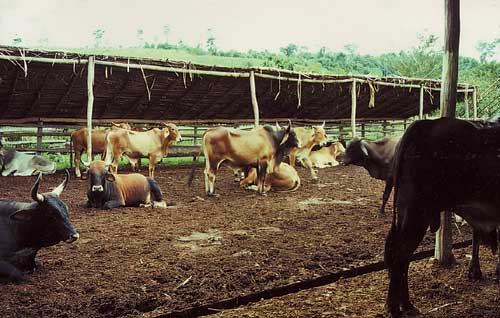
PHOTO 79
HEIA: cattle standing in a corral with plenty of dung. The animals are fed with local maize and cottonseed cake; they will be slaughtered and flown to the capital for consumption (Peru)
The use of dung and urine excreted by cattle, pigs, chickens and other animals for crops is traditionally raised as an argument in favour of keeping livestock. Dung and urine contain several nutrients such as nitrogen, phosphorus and potassium, and the solid fraction contains organic matter that is important to maintain soil structure and fertility. Occasionally it is even believed that dung and urine have medicinal qualities, but more commonly the dung is used as fuel (as dungcakes, through biogas), while it can also be used to plaster walls when mixed with clay. The belief in the medical value may have some justification, e.g. through the occurrence of antibiotics in dung and through the presence of lignin derivatives in dung that help to make it sticky or even to give it bactericidal properties.
The use of dung and urine for soil fertility is most cited. It is particularly important in LEIA and NCA, but unimportant in EXPAGR. The term dung "production" is misleading because animals excrete only nutrients that they first have to eat. Animals can carry nutrients from one place to another, they can increase the rate of their turnover or they can concentrate the nutrients from the outfield to the infield, i.e. they concentrate the fertility of a large land area on relatively small cropping areas around the villages. The "production" of dung in HEIA is a disadvantage rather than a blessing and elaborate systems are designed to dispose of dung rather than to use it.
Organic matter comes from manure, household waste and compost, or from incorporating weeds into the soil. The tasks involved in producing and using organic fertilizer are divided among different members of the household. Young people or labourers tend to collect the crop residues, to dig compost pits when needed and to transport the organic fertilizer to the field while the head of the family is responsible for managing its production. Women make organic fertilizer from household waste and keep some of it back for use on their own small plots of land. The major nutrients in fertilizer and dung are needed to make plants grow and produce:
Terms and technologies associated with crop-livestock integration, soil fertility and animal nutrition
Fallow |
Allowing the land to remain idle so that it can rebuild itself in terms of soil fertility, soil structure and soil life; or to ensure that disease and weed pressure will be reduced |
Ley |
A cultivated fallow planted with fodder crops that actively suppress weeds or disease, bind nitrogen, mobilize phosphorus, add soil organic matter or reduce runoff, etc. |
Infield |
The cropping area around villages or homesteads that is fertilized with excreta and with litter from the outfield |
Outfield |
The grazing lands, waste lands and forests around the village where animals are grazed or the faraway crop fields of a village |
Catch crop |
A crop that is planted to "absorb" nutrients in the soil that are released through weathering |
Anti-erosion bund |
A ridge planted (on the edge of a terrace) to avoid runoff |
Straw |
The stems and leaves of mature fine cereals such as rice, wheat, barley, oats and rye |
Stover |
The mature stems and leaves of coarse cereals such as maize, sorghums and millets |
Grain:straw ratio |
The ratio between grain and straw, i.e. a grain yield of 2 000 kg/ha associated with a grain:straw ratio of 1.5 results in a straw yield of 3 000 kg/ha |
Harvest index |
The proportion of the above ground biomass (in the case of cereals) that is found in the grain, i.e. a harvest index of 33 percent results in a ratio of 2 kg straw:1 kg grain |
Excreta |
A combination of dung and urine |
Manure |
Farmyard manure, excreta (the solid part) of animals that is to a lesser or greater degree mixed with straws and other leftovers |
Soil organic matter |
Organic matter originating from plants and/or dung that occurs in several degrees of decomposition in the soil, and in different degrees of solubility. It serves to enhance structure (on heavy soils) and water/nutrient holding capacity (on light soils) |
Zero grazing |
The keeping of animals in a shed, based on feed that is brought in from elsewhere (on-farm and/or off-farm) |
Mulch |
The mix of dry and/or green materials that can be used to cover the soil for prevention, for example, of erosion or excessive temperature effects |
Compost |
Organic matter (with or without animal excreta) that is decomposed on a heap or in a pit before applying it to the soil |
The amount and quality of urine and dung produced depends on the type of animal, its size and the type of feed as well as on the management of the farmer. One way to calculate the amount of manure produced is:
After the harvest a part of the crop residues tends to be freely accessible to all livestock including those from outside the village. The residues consist of straw that is sometimes left in the field or carried home and they contain stubble and ratoon (green regrowth of the crop) which can be grazed (Photo 101). Another part of the residue is fallen grain - in Asia this is used by ducks. Weeds can also be considered as crop residues and in wetter areas or seasons they can form an important feed resource. Sometimes they are cut and carried home during the cultivation period when access to grazing grounds is difficult for animals.
The nutrient content of manure and other organic fertilizers varies according to the quality of feed and the way it is stored and handled. Table 10 gives an indication of the concentration of the main nutrients in the manure of cattle and small ruminants and other sources of organic fertilizer. Dry matter content of manure also varies widely; in cows on lush pasture it can be less than 15 percent but in sheep on dry forage it can be higher than 50 percent.
The amount and proportion of nitrogen excreted depend on animal diet. The urine and solid dung of animals fed highly digestible diets with a lot of protein contain much more nitrogen and, therefore, are more susceptible to nitrogen losses than excreta from diets containing greater amounts of roughage. Much of the urine nitrogen is lost via ammonia volatilization. Where animal management tends towards increased stall-feeding, the composting of fresh manure will have to play a greater role in minimizing nutrient losses. Pits or heaps that capture feed refusals, manure and urine and household waste need to be designed to minimize nutrient losses. Low-cost appropriate implements to spread the compost at the appropriate time over large cultivated areas such as the Sahel are also needed (based on Powell and Williams, 1993).
In various systems draught oxen, donkeys, horses and small ruminants are kept overnight in pens in the compound throughout the year, and the manure they produce is transported to the fields during the dry season. Droppings of donkeys, sheep and goats are often added to the heap of household waste. However, droppings from small ruminants are sometimes used separately, for example on infields to manure certain spots in the millet crop. Manure from small ruminants takes longer to have an effect on crop yields than cow dung, but once it has started the effect lasts for several years. As this dung is kept the nitrogen losses can be reduced by mixing with low quality biomass, i.e. with straws, leftover feeds, dry leaves, etc. The greener leaves still contain much nitrogen themselves and they are less capable of capturing surplus nitrogen from urine and dung.
Nutrient contents of manure and other organic fertilizers (percentage)
Organic fertilizer |
N |
P |
K |
Dry matter |
Cattle |
||||
Fresh manure |
1.4-2.8 |
0.5-1.01 |
0.5-0.6 |
15-25 |
Kraal (litter) |
0.5-2.3 |
0.22-0.81 |
0.77-5.44 |
40-60 |
Kraal (no litter) |
1.5-2.5 |
0.2-0.6 |
1.5-2.0 |
30-50 |
Goat and sheep |
|
|
|
|
Fresh manure |
2.2-3.7 |
0.25-1.87 |
0.88-1.25 |
50-70 |
Fresh green manure |
2.0-4.3 |
0.1-0.3 |
1.0-3.4 |
|
Compost |
0.3-0.9 |
0.07-0.17 |
0.14-1.3 |
|
Household waste |
0.2-0.9 |
0.05-0.5 |
0.1-2.1 |
|
Ash from farm cooking |
0.2-0.6 |
0.1-0.6 |
1.1-2.7 |
|
Source: Based on a compilation by Defoer et al. (2000).
Household waste consists of partially decomposed waste from a variety of origins. It plays no part in fertility management where land is abundant. However, farmers are prepared to work hard to retain nutrients on their soil when land for cultivation becomes scarce and when food demands increase (LEIA and NCA). For example, farmers in Dilaba, Mali, said they started applying household waste in the 1970s after the drought, combining it with cow dung and the droppings of small ruminants. The system is now widely used in Dilaba and it is also starting to gain ground in the surrounding areas. The amount applied by different farmers depends largely on how much they are able to transport and on how much they can collect (Photos 82 to 85).

PHOTO 80
A woman fertilizing a crop field with great care and precision (Kenya)
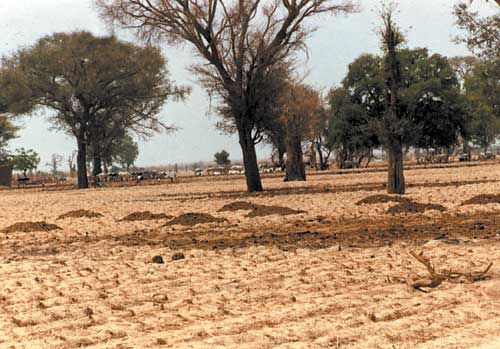
PHOTO 81
Corrals on cropland to fertilize the fields with the dung of cattle that spend the night in the corral (Sahel, Mali)
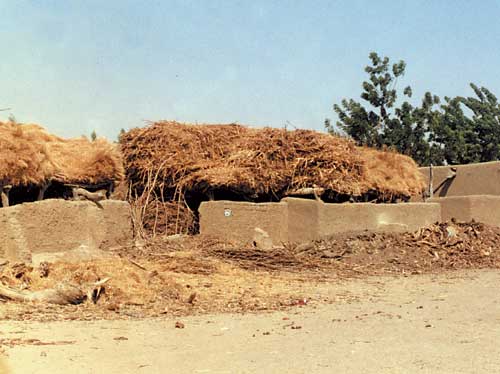
PHOTO 82
Household waste heap near the compound and fodder storage on the compound (Dilaba, Mali)
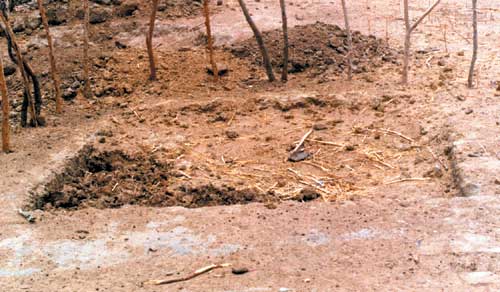
PHOTO 83
Compost pit filled with organic waste in the process of decomposition (Dilaba, Mali)
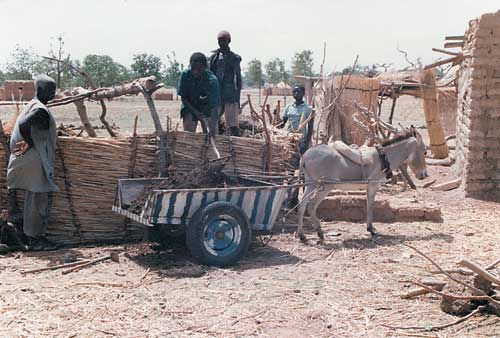
PHOTO 84
The transport of compost with a donkey cart. The compost is moved to the crop fields (Burkina Faso)
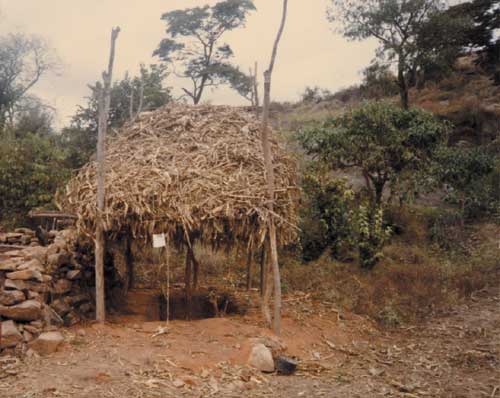
PHOTO 85
Empty compost pit and stover storage above the pit (Zimbabwe)
Composting is a process to break down the organic materials to make the nutrients in the biomass accessible to plants. It also helps to make a fine, easy-to-handle material and, if well done, the composting kills weed seeds. Compost is normally produced from a mixture of all kinds of organic waste, including crop residues and household waste. The technology is very ancient and there are many different ways to compost organic materials. The most common method uses a moist heap with enough nitrogen for the breakdown of the organic material that is regularly turned to allow air and oxygen to enter the heap.
Different kinds of nutrient losses can occur during crop cultivation and post harvest:
Animals leave their droppings while they graze the stubble, so even farmers without livestock will receive some on their fields. However, the quality of the dung is likely to deteriorate if left lying on the field unprotected for up to six months, even when it is stacked and stored in the open (Photo 86).
Grazing animals do not "produce" nutrients in dung and urine; actually they remove more biomass and nutrients from cropland than they return in the form of manure, as shown by studies in some West African countries (Table 11).
Cereal stover removals and manure returns during crop residue grazing in West Africa
Location |
Total (kg/ha) |
dry |
matter (kg/ha) |
Nitrogen (kg/ha) |
Phosphorus |
Stover removal | |||||
Nigeria |
2 470 |
|
|
24.5 |
3.9 |
Burkina Faso |
1 570 |
|
|
14.8 |
4.0 |
Niger |
2 135 |
|
|
16.8 |
1.8 |
Manure returns | |||||
Nigeria |
27-272 |
|
|
0.3-1.7 |
0.1-0.3 |
Burkina Faso |
600-1 600 |
|
|
7.5-20.0 |
1.5-4.0 |
Source: Powell and Williams (1993).
Activities to prevent or reduce nutrient losses are:
The survival of farmers in mixed systems depends to a large extent on a proper adjustment of soils, plants and animals. Techniques suggested in this report include:
These techniques can help in several ways either to reduce erosion, to add nitrogen, to enhance phosphorus flow rates, to pick up leached nutrients or to provide feed.
Farmers in most EXPAGR regions tend to depend on fallow as the technique for restoring soil fertility. This is possible because there is plenty of agricultural land available and entire fields can be left fallow for long periods of ten years or more. The system resembles shifting cultivation and the location where crops are cultivated changes every couple of years. However, over the years, with increasing population and changing technology, the fallow period has become shorter and, in areas with a dense population, it has disappeared almost entirely.
A ley is a fallow that is planted with crops such as grass or legumes to regenerate the soil more rapidly. The grass is used as fodder if animals are present on the farm, but similar systems are used when only mixing between crops takes place. In Mali, for example, farmers grow millet and cowpea on the same infield year after year. When they find that the fertility of part of the plot has fallen significantly, they change the association to pure stands of groundnuts or Bambara groundnuts. The following year they apply organic fertilizer and then start cultivating millet/cowpea again. Such a strategy is widely used in the Sahel. In other words, a ley is a crop rotation that includes animals. To some extent it is also the system used in the Gangetic plains and in the Nile delta, where berseem and/or mustard are rotation crops used exclusively for livestock feeding, either on-farm or off-farm (Photo 90). The system is being tried in northern Thailand (Gibson, 1987), and is also practised in the Krishna Valley of eastern India where a legume (pilipesare) is the main rotation crop. However, use of legumes is also common in the United States, in western Europe and in the so-called Mediterranean systems that even occur in Australia (see Chapter 8).
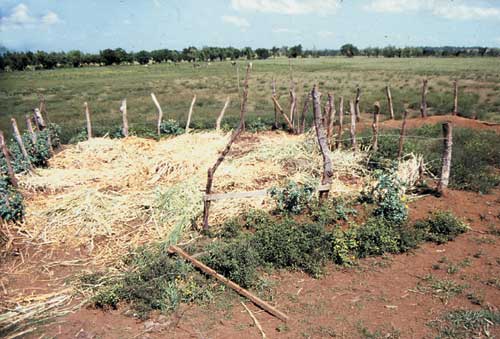
PHOTO 86
Manure heap in the open air: nutrient losses here are high (Nicaragua)
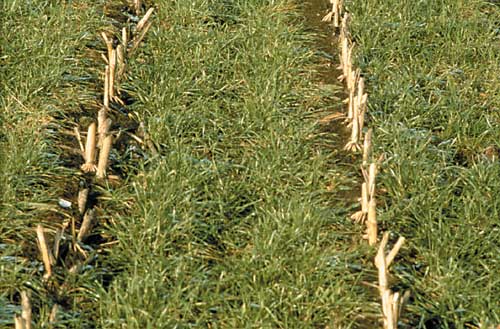
PHOTO 87
Catch crop sown between a (harvested) maize crop, to protect the soil and produce fodder
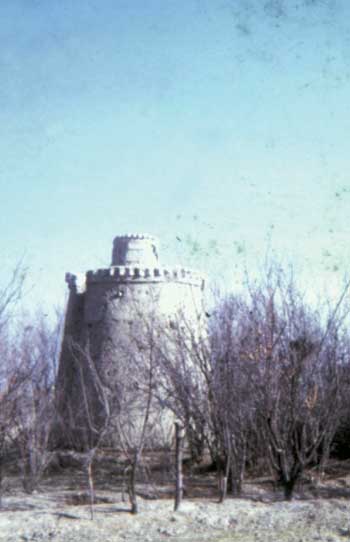
PHOTO 88
Traditional pigeon tower for dung collection in Iran
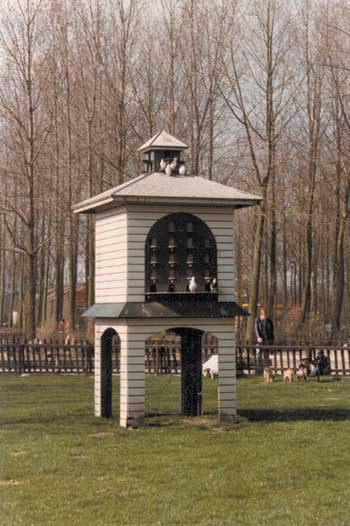
PHOTO 89
Pigeon tower in the Netherlands. Such towers are cleaned regularly and the excreta can be stored and used as fertilizer
Integration of crops and livestock is often considered as a step towards sustainable agricultural production because of the associated intensified organic matter and nutrient cycling. Residues of the different crops represent the main on-farm source of organic matter and nutrients. This combines well with the presence of livestock since animals play a vital role as capital assets for security and as a means of saving, for cash income and in nutrient flows. Management of crop residues in such regions is closely related to their utilization in animal feeding.
An advantage of the integration of livestock and crops is the added value derived from crop residues (especially those of legumes) in terms of animal products and income. However, to maintain the system in the long term it is necessary that nutrients from external sources are added. In the past, this was covered to some extent through fallowing and manuring contracts with pastoralists, but the growing demand for feed by the increasing herd (from both arable farmers and pastoralists), the shrinking area of cropland per capita and declining crop yields dictate the scope for improvement through integration of crops and livestock. The extra input must come from inorganic fertilizer as well as from concentrates or both. Often, the price ratios of fertilizer and grains are not conducive to the utilization of fertilizers, and development of institutional and physical infrastructure for cost-effective use of fertilizers and concentrate is required to trigger sustainable land use in the region. Use of concentrate can be remunerative for farmers but credit facilities may stimulate intensification of livestock production and thereby increase availability of nutrients for crop land (based on Savadogo, 2000).
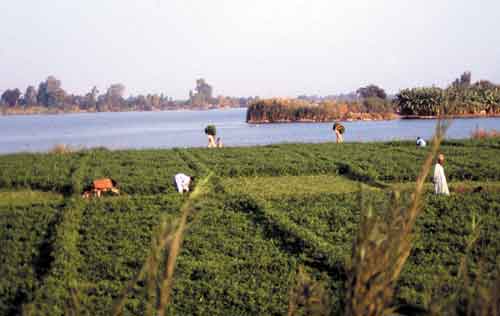
PHOTO 90
The use of berseem as a nitrogen-binding catch crop and animal feed along the Nile delta. Animals are used to carry the feed home. The system is labour-intensive, and these fields are used for wheat and/or rice in other parts of the rotation
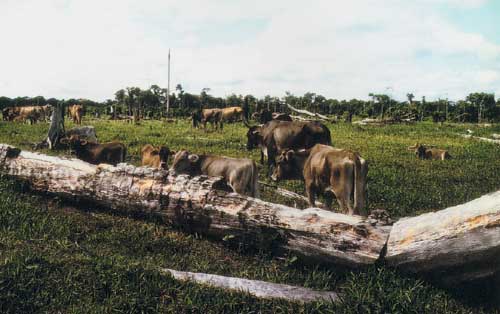
PHOTO 91
In South America large parts of the forest are cut to let cattle graze. This often leads to degradation of the environment because of improper management
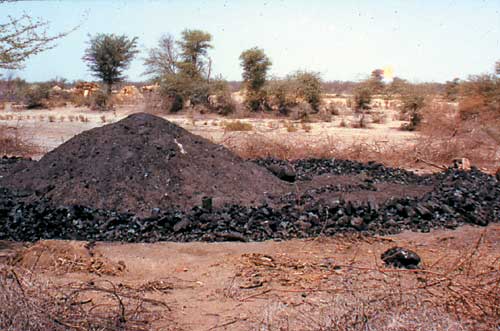
PHOTO 92
Charcoal production: it is not only animals that cause erosion (Senegal)
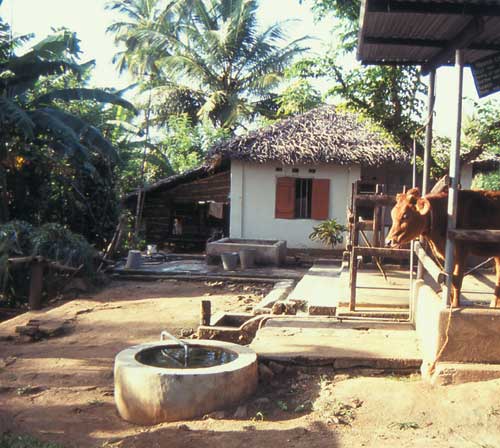
PHOTO 93
Biogas installation on a rural compound (Sri Lanka)
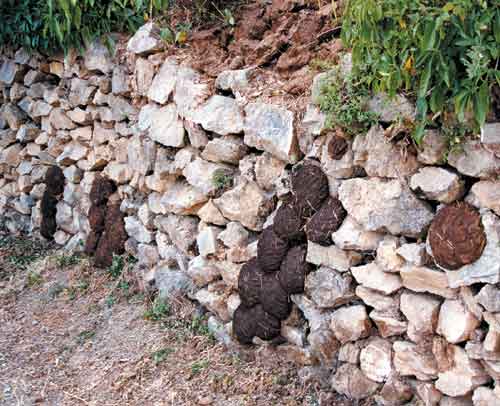
PHOTO 94
Dungcakes can be used as energy for cooking - this is often the case if wood is hard to come by (India)
Animals can also play a role in the provision of energy. Sometimes this role is very negative where livestock keeping contributes to deforestation in large parts of South America, Asia and Africa (Photo 91), but it can also be positive, such as by transforming plant energy into useful work or by providing dung used for fuel through dungcakes or biogas to replace charcoal (see Photos 92, 93 and 94). Wood and charcoal will con-tinue for a long time to provide energy for household cooking and for rural industries but increasing energy demands and increasing pressure on natural resources call for measures such as a more efficient use of biomass, improved natural resource management, fuel switching from, for example, charcoal to kerosene or liquefied petroleum gas, and for the development of alternatives such as biogas. The principal uses of biogas are for household energy, such as cooking and lighting, although larger installations can produce sufficient gas to fuel engines, for example, for powering mills and water pumps.
Despite the merits of biogas technology, bio digesters have only been widespread in India (over 5 million installations) and in China (nearly 3 million installations). In these countries it is common to find biodigesters even in remote villages provided there is enough water. For example, an ambitious programme in Nepal is accelerating market development of small biodigesters. In many countries, some practical experience has now been gained with the dissemination of biodigesters but larger-scale dissemination has not yet become popular, despite the assumed economic, environmental and social benefits of the technology. The main reasons seem to be that the multiple benefits of biodigesters must be acknowledged by the end-users to convince them to invest in the technology, and that a market-driven institutional infrastructure should be in place to facilitate large-scale dissemination of the technology. Much work has been done on mixed crop-livestock systems including the use of biogas, for example in the well-known CIPAV project in Colombia where pigs, sheep, sugar cane and biogas are just some of the components studied (FAO, 1992c).
Three designs can be distinguished among the small-scale and low-cost biodigesters:
Roughly speaking, a well-constructed fixed-dome biodigester has the longest lifetime: 20 years and more. The floating-drum digester can have a comparable lifetime, but the recurrent costs are higher as the steel drums have to be replaced every five to ten years due to corrosion. The lifetime of the flexible-bag digester is hard to indicate, as some do not last more than a couple of months, while others function for several years.
Complex microbiological processes take place within a biodigester. In a common farm-type digester, the temperature ideally varies between 30 and 40 degrees Celsius. The process can be divided into three steps. During the hydrolysis phase, the complex molecules in the feedstock are broken down into smaller molecules. During the second phase, volatile fatty acids are formed. Finally, during the methanogenic phase, other bacteria use the acids to produce methane. The methanogenic bacteria can only do their work under anaerobic conditions (without oxygen), i.e. it is important for a biogas plant to be built of leak-tight materials. In practice, the three phases of the process take place simultaneously in a digester where the different bacteria work together in a symbiotic relationship.
Many different types of organic matter can be used to "feed" a biodigester, but to allow the bacteria to do their work the organic matter should be accessible to them. This means that pretreatment is sometimes necessary, e.g. through chopping and/or composting of crop wastes. The easiest feedstock to use is cattle dung, as it already contains the right bacteria and the vegetable matter has been broken down by passing through the guts (and teeth) of the cow. Human excrement and manure from chickens and pigs are also useful, but they do not contain the right bacteria and they need a starter in the form of, for example, some slurry from a working biodigester. Neither the feedstock nor the water should contain toxins such as antibiotics, detergents and disinfectants. Toxins cause the digester to "go sour", causing it to give off an unpleasant smell of acids and, therefore, the dung of cows that receive antibiotics should not be fed into the digester. Cultural aspects might influence the selection of feedstock. For example, Hindus in India usually accept cow dung for use in biodigesters, while pig dung and human excrement are often not accepted, particularly in Moslem regions.
Initially, biodigesters were promoted only for their energy production. Once again, the thinking about a technology in a mixed system focused on only one aspect. Unfortunately little attention has been paid to the excellent properties of the slurry as an organic fertilizer of crops and trees. In other words, slurry has the potential of supporting crop production and, in addition, the process kills or substantially reduces the amount of pathogenic germs and seeds of weeds present in the feedstock. Another advantage is that nutrients that are already present in the feedstock, such as nitrogen, potassium and phosphorus, are made available to crops more quickly and efficiently, i.e. the biodigester affects the nutrient dynamics of the system. Further, it reduces the odours given off by manure and compost. Emissions of greenhouse gases are also reduced, as the biodigester produces renewable energy (biogas) and because fossil fuel based chemical fertilizer is replaced by an organic fertilizer (the slurry). A major disadvantage of the slurry is that it is liquid, with a dry matter content of less than 10 percent. Transport to the fields is therefore often complicated and the use of the slurry is usually limited to fields near the digester. Larger installations in industrialized countries separate the slurry into a liquid and a solid fraction; the solid fraction can be applied on fields at a distance from the digester.
Alley cropping is an agroforestry system particularly for the humid or subhumid areas, developed at the International Institute of Tropical Agriculture (IITA), Nigeria, but based on earlier farmer experience (ITK). In this system food crops are grown in alleys formed by hedgerows of trees and shrubs, preferably legumes. In most tests and projects the fast-growing species Leucaena leucocephala and Gliricidia sepium (indigenous in Asia [Philippines]) have been used. The hedgerows are pruned regularly, thus providing fodder and fuelwood, and/or mulch. They are pruned to reduce shading for the crops sown in the alleys and the approach is considered to be an improved bush-fallow system permitting continuous cropping, among other reasons, because the tree is a giant "catch crop" that recycles nutrients leached to deeper soil levels. The alley cropping system can sustain or even improve soil fertility and crop production. The system, like any other mixed system, produces tree products such as firewood, stakes for construction wood and fodder for livestock. The latter is mostly used by cattle and small ruminants. Alley cropping is being developed with different tree species and crops, focusing on several uses of the by-products from the trees.
Alley cropping as such is not the solution to all soil fertility problems. Like other technologies it works only under certain climatic and economic conditions. Disadvantages are that it requires much labour and that feed cannot always be delivered on time. It also takes up space, i.e. it is again a reflection of the communal ideotype serving several goals and adjusting to other components in the system. A more intensive form of alley cropping is that of agroforestry in humid lowland tropics in a broad range of systems, some of which are traditional, such as multistorey gardens. Semi-arid areas have low rainfall and tree densities are therefore lower, i.e. windbreaks can serve as a variation on the theme of agroforestry, for example in the Niger with neem trees. In highland agriculture, together with grasses and shrubs, trees can be part of an erosion control system, as found in the Rwandan contour ploughing example that uses Grevillea robusta trees on the contours (based on Müller-Sämann and Cotschi, 1994).
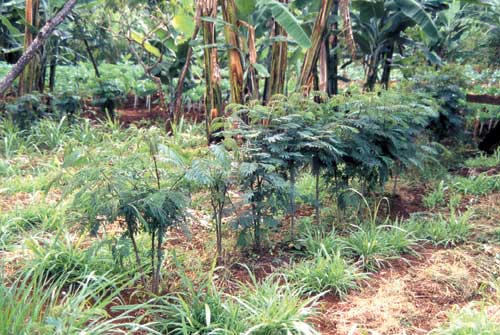
PHOTO 95
Agroforestry in Kenya: a field with Leucaena leucocephala, napier grass and, in the background, banana
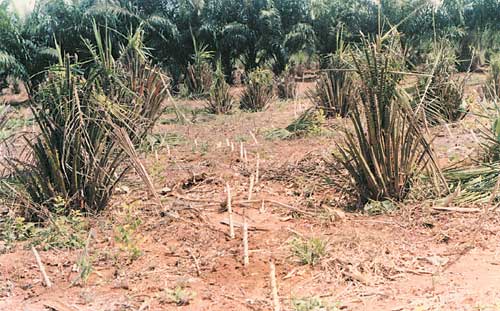
PHOTO 96
Agroforestry in Benin: cassava cuttings planted in a field with pruned oil palm
The fascinating aspect of discussing crop-livestock technologies is that one has to think beyond the confines of either crops or livestock alone. In order to understand the issues at stake one has to know details about crops, animals, soils and people - and all the associated details. The technical issues concern first the intricacies of integration, i.e. the mutual adjustment over time and space of crops and animals (crop rotations, use of crop residues as feed and use of excreta for crops). Secondly, they stimulate the (re-)discovery of techniques that were traditionally in use in many societies, but that have been forgotten because of the emphasis on only crops or animals. In other words, techniques such as the use of fallow, leys and catchcrops that have been the basis of many sustainable farming systems in the past. However, the emphasis on specialized forms of production based on high input use has made them disappear from curricula, research agendas and policy fora. The rediscovery of these technologies can combine with new research techniques to improve our understanding of when and where these approaches can be useful. Thirdly, this kind of work represents a very interesting and relevant area for testing and elaborating modern insights and concepts from system analysis, also for other sectors of society such as industry, habitat and tourism. Concepts to be elaborated could be the hierarchy theory, the effect of energy supply on issues of scale (between-farm mixing rather than on-farm mixing when oil prices decrease), and on issues of diversity (sustainability will increase if the system does not depend on one kind of activity alone). Some of these issues are discussed in the next chapter, by looking at the management of technology at several levels and by including the organization of the "human factor" - the difficulties as well as the opportunities.